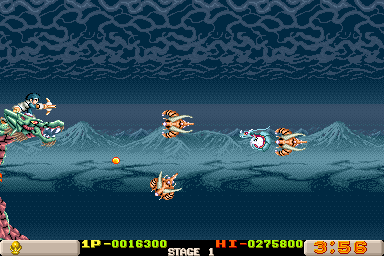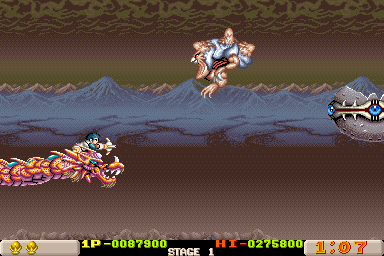Dragon Breed for Arcade
ArcadeGame controls in browser
Show Controller & SystemClick on play Arcade game now button first to load the game into the emulator. Before the start do not forget to toss the coin first (key 1) into the machine slot. Arcade controls:
Dragon Breed
Online version of Dragon Breed for Arcade. Dragon Breed (Doragon Burīdo) is a horizontally scrolling shooter video game produced by Irem and released in arcades in 1989. It runs on M72 and M81 hardware. Activision released home computer ports in 1990. The player controls King Kayus, who rides a large dragon named Bahamoot. Bahamoot is immune to enemy attacks, capable of blocking most projectiles and damaging enemies on contact; Kayus, however, is not, but is armed with a forward-firing crossbow. Bahamoot's body is flexible and responds to Kayus' movement, enabling Kayus to use Bahamoot as a mobile shield or as a whip-like weapon. The player can also circle the tail around a group of enemies to kill them. The tail of the yellow or blue dragon can be coiled around the player to offer almost complete invulnerability for a limited time...
Game details
Other platforms online 2
You can play Dragon Breed online also in a versions for75%
rating (1 users voted)
Covers - Box Art
Arcade game
Online emulated version of Dragon Breed was originally developed as arcade game or coin-op game,
a coin-operated entertainment machine typically installed in public businesses such as restaurants, bars and amusement arcades. Most arcade games are video games,
pinball machines, electro-mechanical games, redemption games or merchandisers. While exact dates are debated, the golden age of arcade video games is usually defined
as a period beginning sometime in the late 1970s and ending sometime in the mid-1980s.
Virtually all modern arcade games (other than the very traditional Midway-type games at county fairs) make extensive use of solid state electronics,
integrated circuits and cathode-ray tube screens. In the past, coin-operated arcade video games generally used custom per-game hardware often with multiple CPUs,
highly specialized sound and graphics chips, and the latest in expensive computer graphics display technology. This allowed arcade system boards to produce
more complex graphics and sound than what was then possible on video game consoles or personal computers, which is no longer the case in the 2010s.
This emulation is powered by MAME (Multiple Arcade Machine Emulator) project, an open-source emulator designed to recreate the hardware of arcade game systems in software on modern personal computers and other platforms. Its intention is to preserve gaming history by preventing vintage games from being lost or forgotten.








